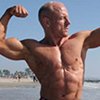From time to time I sit in amazement at some of the comments and questions I get from bodybuilders after each contest: "I should have beaten him" and "Why didn't I place higher, my mother said I was better than the guy that beat me so why didn't I win?" 999 times out of 1000, you just weren't good enough... period!
Now this may seem harsh, but I have been involved in bodybuilding all my life and had the good fortune of being born into a bodybuilding family. I attended my first show in September 1978, two months before my first birthday.
I have been competing for 15 years which is now half my life. I've seen every show from the Mr. Limerick (my hometown) to the Mr. Olympia, so I have seen it all, heard it all and done it all.
I have been judging bodybuilding contests the world over for over a decade and one thing is for certain, we are all the same. We all have the same questions after the contest and we all have the "shoulda-woulda-coulda" attitude.
This attitude takes a little management because after all, the decisions made at bodybuilding shows are not like running the 100m faster than the guy in the lane next to you, or punching your opponent into submission in the UFC.
Scoring
Bodybuilding is all about subjectivity—We as judges subjectively critique each athlete's physique and compare and contrast each competitor in the line-up and place each athlete accordingly. Now, as subjective as the sport is, measures are taken to maintain as much balance in the scoring structure as possible.
The highest score is taken out and the lowest score is taken out, leaving each athlete with the same number of judges marks (i.e. if there were 7 judges, the competitor would have 5 judge's results). These scores are then added to make a total score.
The individual with the LOWEST total score is deemed the winner with the next lowest coming in second and so on and so forth. So how does an athlete gain an advantage in points throughout a bodybuilding contest?
Presentation
The judges break the show down into 4 rounds: symmetry, muscularity, size (muscular development), and presentation. Each round carries equal weight in the overall outcome of the contest.
In the symmetry round athletes are put through 4 poses, which are called quarter turns, turning to the right each time, with heals together. This allows for the judges to evaluate each athlete for weaknesses in the development of muscle groups in comparison to other muscle groups, while simultaneously comparing one athlete to another. In the muscularity and size (muscular development) rounds the athletes are put through eight compulsory poses:
- Front Double Bicep
- Front Lat Spread
- Side Chest Pose (Either Side)
- Side Tricep Extension (Either Side)
- Back Double Bicep
- Back Lat Spread
- Most Muscular (Men Only)
The presentation round is judged at the finals. The most frequent question I get asked as a judge on the amateur level is, "What do I need to do to place higher?" The obvious answer is to improve your physique by bringing up your weaknesses. That would entail improving on the symmetry, with no particular muscle group overpowering another.
A great example of imbalanced symmetry is having great quadriceps development and poor hamstrings and calves, although having great calves can make the legs appear better developed than they actually are.
Other really common symmetrical imbalances in bodybuilding are the over-developed deltoids, which make the pectorals look inferior, or over-developed pectorals, which give the impression that the arm development is inadequate. Once you have each muscle group in balance, the next step is getting the conditioning right.
Tanning
An athlete should not be so ripped that the muscle is "stringy," this is bodybuilding after all. However, the athlete should not be so full that the muscles lack definition; balance is the key! After the physique has been taken care of, the next step in the presentation is making sure the tan is right.
The goal is a nice, dark and even tan that doesn't run. Certain tanning products are not recommended and others are actually not allowed at IFBB International events.
Posing
is the most vital part of your presentation. If you cannot show off your physique then how are we as judges able to judge? You should be showing off what you have worked so hard for in the off-season and enjoying the fruits of your labor.
A little piece of advice: do not use DVD's like the Olympia or Arnold or any pro show to learn how to perfect you stage presentation. Also, don't forget that they are pros. Pros such as Phil Heath and Dexter Jackson are there to entertain the fans and to a degree this is the case during the comparisons where they take their time waving on the fans support. It is all part of the professional game and to a degree, even the Pros have time limits.
As an amateur it is important to remember, when the pose is called hit it as best you can to allow all the judges to see before the next pose is called. However, using those DVD's to gain insight into choreographing your individual posing might not be a bad idea, you will be learning from the best. With that in mind what's stopping you? Get on that pre-contest diet and get onstage at your local NPC/IFBB amateur show. You know what the judges are looking for so show us what you've got!
